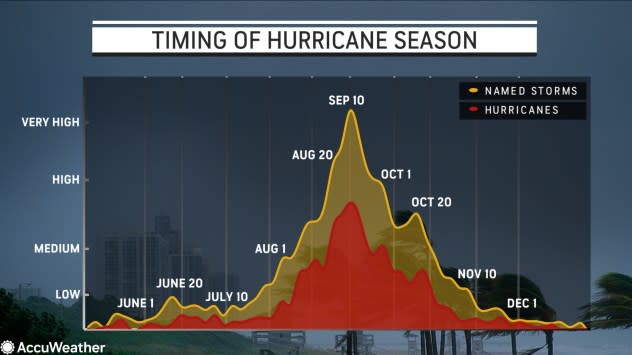More hurricanes? AccuWeather forecasters say Atlantic tropical season isn't over yet
The 2022 Atlantic hurricane season has been a roller-coaster ride. The season began with a quick burst of storms in June and early July and was followed by a historic pause in tropical activity from mid-July through the end of August before it ramped up dramatically in September.
Hurricane season in the Atlantic basin continues through Nov. 30, but with most of the season in the rearview mirror, some people may be wondering how many more storms will develop.
AccuWeather Senior Meteorologist Paul Pastelok explained that one of the most significant factors that will dictate the remainder of the Atlantic hurricane season is wind shear, or winds that can disrupt the formation of tropical systems.
"There is just way too much shear in the basin," Pastelok said. It is unlikely that a named storm will develop through the end of the week, but the chance of development will increase near the end of October and even into November.
AccuWeather long-range forecasters predict that there could be another two or three storms from late October into the first part of November. Pastelok elaborated on this, saying that one of the storms could spin up near the Lesser Antilles or off the coast of the Southeast, meaning that another U.S. landfall cannot be ruled out.
 |
Hurricane Fiona, a Category 4 storm, photographed with the GOES-16 satellite on Sept. 21, 2022.(CIRA/NOAA/NESDIS) |
Despite the presence of La Niña, a climate phenomenon that typically leads to above-normal tropical activity in the Atlantic, the 2022 season has been near to below average in terms of the number of named systems that have formed since June 1.
During an average season, there are typically 12 named tropical systems. Of those storms, about six become hurricanes and about three become major hurricanes (Category 3 strength or greater), according to the National Hurricane Center. Counting Tropical Storm Karl, the most recent named storm in the basin, there have been 11 tropical storms, five hurricanes and two major hurricanes -- Fiona and Ian. The next named tropical system will be given the name Lisa.
Another way to gauge the season is by analyzing a parameter known as Accumulated Cyclone Energy, or ACE. The parameter measures the intensity and duration of tropical storms and hurricanes. Strong, long-lived hurricanes, such as Hurricane Fiona, generate an abundance of ACE while weaker, short-lived systems, such as Tropical Storm Karl, produce very little ACE. As of Sunday, Oct. 16, the ACE for the 2022 season was 84.1 units, well below the average for this point in the season of 107.2 units, according to figures compiled by Colorado State University researchers.
The 2020 hurricane season brought a record 30 named storms, while the 2021 season brought 21 named systems. A La Niña pattern was also present during those seasons.
"One potential factor in holding back tropical storm and hurricane numbers, compared to the last two extremely active La Niña years, may have had to do with the eruption of the underwater Tonga Volcano in January," Pastelok said.
Major volcanic eruptions over the centuries have resulted in well-documented short-term climate change, such as the 1883 eruption of Krakatoa in Indonesia. Average temperatures throughout the Northern Hemisphere fell by nearly 1 degree Fahrenheit (0.5 C) over the following year.
"The Tonga eruption spewed massive amounts of water vapor high into the atmosphere, and because this occurred in the tropics, it may have simply cut down on thunderstorm development, which is the precursor to tropical systems," Pastelok said. "And, it's not just in the Atlantic basin where we have seen a drop in tropical cyclone numbers, but the Pacific and Indian oceans as well."
The fallout from the volcano eruption could also play a role in the weather across North America during the upcoming winter.
 |
This satellite image made by the Japanese weather satellite Himawari-8 shows the eruption of the Hunga Tonga-Hunga Ha'apai undersea volcano near the Pacific nation of Tonga on Saturday, Jan. 15, 2022. (Japan Meteorology Agency via AP) |
Even though the Atlantic hurricane season runs through the end of November, fewer than 10% of all named tropical systems on record have developed in the month. Still, people who live along the Gulf Coast or Atlantic Seaboard should not let their guard down.
The last time that there was no tropical activity in the Atlantic basin during November was in 2018. Since then, every November has featured at least one named system, including November 2020, which spawned Hurricane Eta and Hurricane Iota. Both hurricanes made landfall in Nicaragua as Category 4 storms.
Eta was also the most recent tropical system to make landfall in the contiguous U.S. in November. After unleashing intense wind and rain over Nicaragua, the storm took an unusual path across the northern Caribbean Sea before making landfall in Cuba. It then made a sharp turn to the west and emerged over the Gulf of Mexico, shifted abruptly to the north and set a course for Florida where it made landfall as a tropical storm near Cedar Key, a city located north of Tampa, on Nov. 12.
 |
Want next-level safety, ad-free? Unlock advanced, hyperlocal severe weather alerts when you subscribe to Premium+ on the AccuWeather app.AccuWeather Alerts™ are prompted by our expert meteorologists who monitor and analyze dangerous weather risks 24/7 to keep you and your family safer.





